ELECTRIC, WITH AN EDGE
A power distribution grid relies on numerous components to deliver power to the population. From power generators to your homes, electricity undergoes a series of “transformations” to enable efficient distribution. This transformation of electricity is the main role of a transformer.
By stepping up the voltage, we allow electricity to travel long distances.
Meanwhile, by stepping down electricity, the high voltage of power from lines becomes usable by the general public. Such is the importance of transformers in the power grid.
This article will discuss the transformer at the heart of power generation, the generator transformer.
Now, if you’re looking for generator transformers or similar electric products, you should check out Daelim Belefic. Jiangsu Daelim Electric Co. Ltd is a trusted electrical manufacturer with over 15 years of excellent reputation.
Daelim has a wide selection of electrical products, including generators and power components.
The company offers high-quality products and ensures compliance with ANSI, IEEE, CSA, and IEC standards.
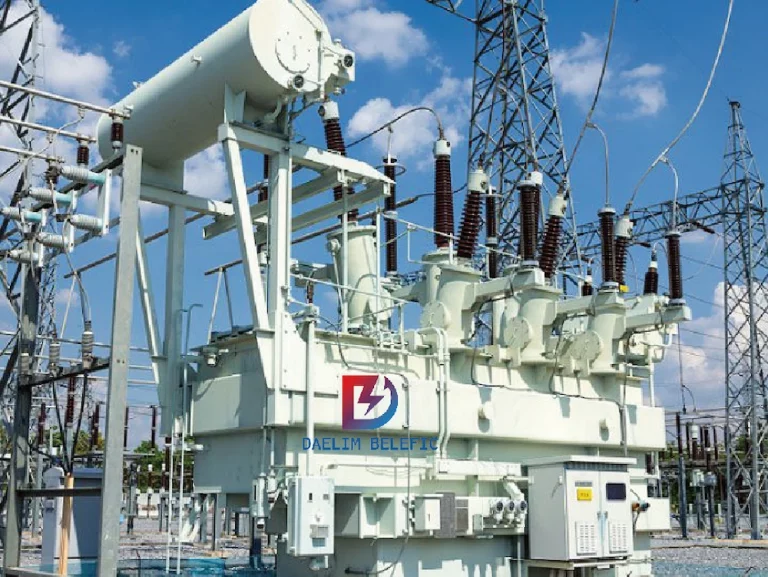
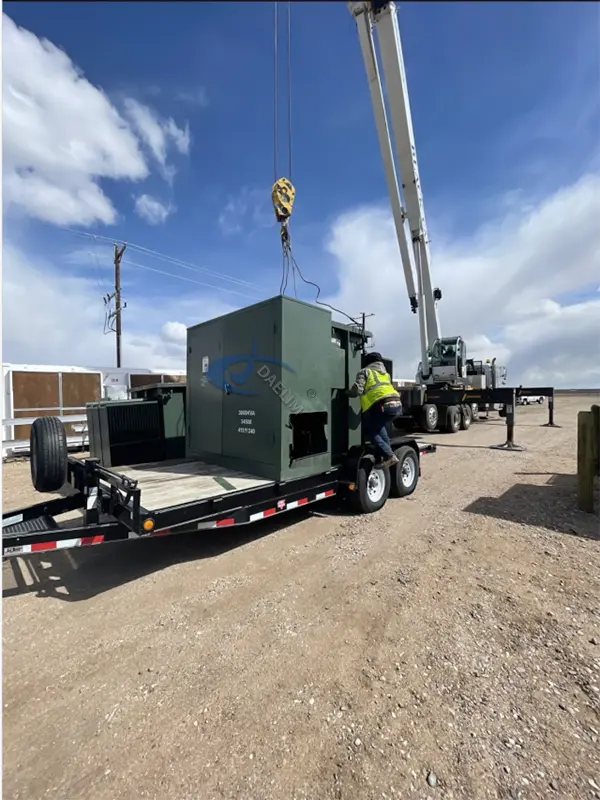
In the dynamic realm of power distribution, the significance of the generator transformer is undeniable. As the heart of many electrical setups, these transformers play a pivotal role in ensuring the seamless transfer of energy. And in this domain, Daelim stands tall, not merely as a manufacturer but as a beacon of innovation and reliability. With over 20 years of profound experience in national transformer projects, Daelim’s legacy is woven with commitment, expertise, and an unyielding drive for excellence. Our extensive portfolio, spanning from Pad Mounted Transformers to HV Power Transformers, is a testament to our dedication to cater to diverse needs. Daelim isn’t just a brand; it’s a promise of quality, efficiency, and unparalleled after-sales support.
Our journey, enriched with global outreach, from the bustling markets of Asia to the demanding terrains of Europe and America, has been nothing short of transformative. We understand that in the world of transformers, one size doesn’t fit all. And that’s why our professional technical team is adept at crafting specialized solutions, tailor-made to the intricacies of various industries. We believe in a customer-centric approach, ensuring that our offerings are not just products but solutions that resonate with your needs, ensuring optimal power distribution.
-The power transformer in the oil field ground construction project is the power core of the entire project. If you choose power transformer solutions for oilfields, what is the principle of selection? How to verify?
-Specification of voltage regulating power distribution transformers (VRDT) .
-Reasons and precautions for tripping failure of the three-side switch of the main transformer in 110kV central substation.
-Through the statistical analysis of performance data such as no-load loss, load loss and noise level of some distribution transformers, we can understand the status quo of the high Voltage Distribution Transformer industry from one side, and compare and analyze the statistical results with relevant standards.
The generator transformer is the most important transformer on a power station and connects the generator output to the grid.
We rate them according to how much power they can carry for that size of the system.
This machine is what directly converts generated electricity to higher voltages which allows easier distribution.
Thus, for this reason, generator transformers are mostly step-up transformers and oil-filled transformers.
Oil-filled cooling is necessary for the more efficient handling of loads.
This cooling is necessary as generator transformers can undergo abnormal power levels and operate at near 100% capacity.
You should also place a generator transformer in a high-risk area with a fire protection system like other oil-filled transformers.
We’ll discuss generator transformer unit protection in the latter part of this article.
Special design considerations are necessary for this transformer to withstand abnormal conditions from thermal and mechanical stress.
A generator transformer is a type of transformer that is specifically designed to step up the voltage output of a generator to the level required for transmission over long distances. It is an essential component of power plants, particularly those that generate electrical power using large-scale generators. The generator transformer takes the output voltage of the generator, which is typically in the range of 10-30 kV, and steps it up to a level that is suitable for transmission over long distances, typically in the range of 100-800 kV.
Generator transformers are available in a range of sizes and configurations, depending on the specific requirements of the power plant. They are typically designed to be highly reliable and durable, as they are critical components of the power generation process. Generator transformers are also subject to strict regulations and standards, which ensure their safety and performance.
A generator transformer is a virtual device that can be single or three-phase units depending on the device’s specifications.
This transformer must endure extreme temperatures without deteriorating as it is subjected to full-time operations at levels of capacity requirements.
Large modern generators are often designed to operate at around 11 to 30 kV. Ideally, the generator designer wants to limit the stator current to meet the desired outputs.
The generation is usually not located near the load centers for economic transmission.
A transformer steps up the voltage output to that of its distribution lines to reduce the load on the generators.
Nowadays, power stations are designed on the unit principle, meaning that each generator will have its dedicated step-up transformer.
It is an efficient way to produce reliable power for the grid.
For the performance requirement, here are industry standards manufacturers should observe:
You should also note that there is a different opinion prevailing on some utilities.
See, on-load tap changers can cause unreliability in areas with the highest priority availability and load factor.
These generator transformer specifications and requirements are just a few you should check before making a deal.
For best and tested performance results, you can consult your trusted transformer manufacturer like Daelim.
From them, you shall receive assistance from professionals who are experts in this field.
Generator transformers are subjected to high-performance demand that can be taxing on the machine.
Thus, machine failure is always part of the consideration and is often prepared with safety precautions.
For this part, enumerated below are the common generator transformers’ unit protection :
It is paramount that all generators, transformers, transmission lines, and distribution feeders are protected from short circuits in electrical safety.
Thus, it is a standard in electrical practice to isolate most vital devices like the generator transformer.
In the most straightforward concept, a fuse detects the fault by burning out and thus isolating the line.
This principle also applies to more complex systems as well.
Such wherein professionals use micro-processing relays to detect the fault and determine which breakers need to activate.
One type of this sophisticated design is the Supervisory Control and Data Acquisition or SCADA.
This system configuration allows for remote or automatic control over components involved in the system.
Devices like the Restricted Earth Fault Protection (REFP) system protects against earth faults.
By breaking the circuit when the fault current reaches the threshold, prevents damage to downstream equipment.
Experts use certain devices to restrict the electrical current in case of an earth fault. Earth fault relay, ground fault circuit interrupter, and earth leakage circuit breaker are among these.
Another method is to apply overcurrent relays to ensure that a short circuit won’t affect your transformer.
Experts place instantaneous relays, and it prevents current from operating when a secondary short circuit occurs.
Differential protection is a type of unit protection that monitors the differential current for faults. It is because the input and output currents are never equal.
As the current in the windings becomes unequal, it energizes the operating coil.
Afterward, it sends a voltage to the load to balance it back out.
As the technology improves, experts get to develop more and more safety features for transformers.
These unit protection designs are vital to keeping your transformers reliability and safety at peak.
Always ask which are the best options for your case when consulting with a manufacturer.
It is important to note that transformer designs and station layout can be varying.
Electrical designers have a set of different considerations that affect the configuration.
Thus, it is imperative to consult an expert for your setup.
Nonetheless, although a variation is commonplace, tried and tested configurations are still prevalent in the industry.
For example, a registered design for the 660 MW generators rated at 800 MVA and bunked with 3 single-phase units.
There are also cases where switchgear is designed to disconnect from the grid and reconnect to the generator automatically.
This design prevents a power overload caused by an electric company’s response to a generator trip.
Generator transformers are usually step-up transformers as they need to ramp up voltage for efficiency considerations.
However, stations also occasionally use step-down transformers to power generator components.
In concept, step-down transformers can be involved in the generator’s output flow.
Meanwhile, step-up transformers are necessary for output regulation.
Technically, we classify generator transformers as power transformers.
These types are expected to perform at higher loading capacities, an estimated 0.85 to 0.95 power factor.
Furthermore, they are undergoing constant load and can face occasional overloads, which they should be designed to withstand.
Power transformers are transformers usually involved in power generation in substations and similar facilities.
Meanwhile, the step-down variant is more prominent as distribution transformers convert high voltage currents to usable rates.
They are the end gateway of electricity before common households can benefit from power.
Unlike power transformers, they can be below 0.75 power factor and handle significantly lower loads.
Although both devices follow the principle of electromagnetic induction, their function is distinct from one another.
A generator is mechanical, while a transformer is static.
A generator converts mechanical power to electricity, while a transformer simply converts the electrical voltage.
A generator consists of a rotating conductor in a magnetic field, inducing an EMF.
Meanwhile, the transformer involves an alternating current in one wire, which changes the magnetic field and induces an EMF in another wire.
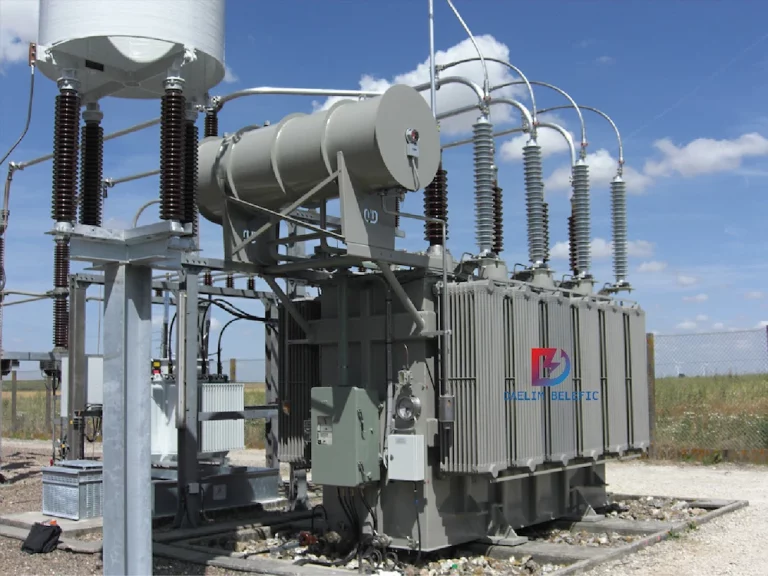
A generator transformer is a type of transformer that is used to connect a generator to a power grid. The connection between a generator and transformer involves a step-up transformer configuration, which is used to increase the voltage of the electrical output of the generator to a level that can be transmitted over long distances through the power grid. The generator transformer is connected to the generator at the output terminals, and the other end of the transformer is connected to the power grid.
The connection between the generator and transformer must be carefully designed and constructed to ensure that the electrical output of the generator matches the input requirements of the transformer. This involves matching the voltage, current, and frequency of the generator with the specifications of the transformer. The connection must also be designed to provide the necessary level of electrical isolation and protection for the generator and the power grid.
In some cases, a generator may be connected directly to the power grid without the use of a generator transformer. This is typically only feasible for small generators that are located close to the power grid and produce a low voltage output. For larger generators or those located further from the power grid, a generator transformer is typically required to step up the voltage of the electrical output and enable it to be transmitted over long distances.
A generator is a device that converts mechanical energy into electrical energy, while a transformer is a device that transfers electrical energy from one circuit to another through electromagnetic induction.
Generators produce electrical energy by rotating a coil of wire within a magnetic field, while transformers transfer electrical energy between two or more circuits by means of electromagnetic induction.
Generators typically operate at higher voltages and generate electricity, while transformers typically operate at lower voltages and transfer electrical energy from one circuit to another.
In a power plant, generators are used to produce electrical power, which is then transmitted through transformers to change the voltage to a level suitable for distribution to homes and businesses.
Generators use different voltage ratings in producing electricity.
With a transformer, you can use the maximum voltage capability of the generator and get more out of that power.
No. Transformers cannot generate power. They simply convert voltage to the desired rating.
Power “generation” is the job of transformers.
For generator transformers and related services, be sure to consult with Daelim.
Daelim has everything when it comes to electrical products and solutions.
Daelim is your partner in cutting-edge electrical innovations and technology.
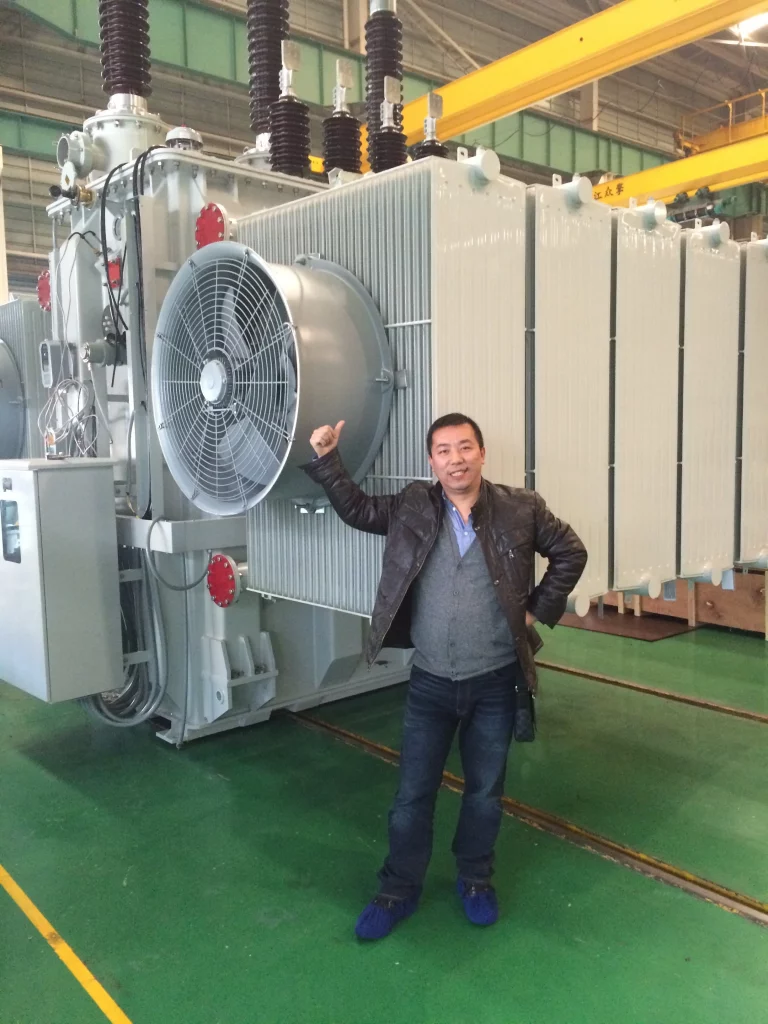
A generator transformer in a power plant is a critical component that facilitates the transmission of power generated by the generator to the power grid. Its primary function is to step up the voltage of the electricity produced by the generator to a level that is suitable for transmission over long distances.
When electricity is generated by the generator, it is produced at a low voltage, typically between 11kV and 22kV. The generator transformer steps up this voltage to a level that is appropriate for transmission over long distances, which is typically 220kV or higher. This high voltage is necessary to minimize the amount of energy lost during transmission over long distances.
The generator transformer also helps in maintaining the stability and reliability of the power system by providing voltage regulation, reactive power compensation, and fault protection. Additionally, it isolates the generator from the power grid, which helps in preventing any electrical disturbances or faults that may occur on the grid from affecting the generator.
In summary, the primary function of a generator transformer in a power plant is to step up the voltage of the electricity generated by the generator to a level suitable for transmission over long distances while maintaining the stability and reliability of the power system.
A generator transformer has several important parts that allow it to function properly. Some of the key parts include:
Core: The core of the transformer is made up of laminated steel sheets that are stacked together to form a closed magnetic circuit. It is designed to minimize energy losses due to hysteresis and eddy currents.
Windings: The windings are coils of insulated wire that are wound around the core. They carry the electrical current and are responsible for stepping up or stepping down the voltage.
Bushings: Bushings are used to connect the windings to the outside world. They are typically made of porcelain or polymer and are designed to insulate the electrical connection.
Tap changer: A tap changer is used to adjust the voltage output of the transformer. It allows the transformer to compensate for voltage fluctuations in the electrical grid.
Cooling system: The cooling system is used to remove excess heat generated by the transformer. This is typically done using oil or water cooling.
Control and protection system: The control and protection system is responsible for monitoring the transformer and protecting it from overloads, short circuits, and other electrical faults.
Each of these parts is critical to the proper functioning of the generator transformer, and they must be designed and manufactured to the highest standards to ensure the reliability and safety of the transformer.
The vector group of a generator transformer refers to the phase shift and the relative polarity between the primary and secondary windings of the transformer. It is represented by a set of letters that describe the phase angle and the winding connection type. The vector group is important for the proper connection of the transformer to the power system, as it ensures that the voltages and currents are in phase with each other. A common vector group for generator transformers is YNd11, which means that the primary winding is connected in a wye (Y) configuration, the secondary winding is connected in a delta (D) configuration, and there is a phase shift of 11.6 degrees between them.
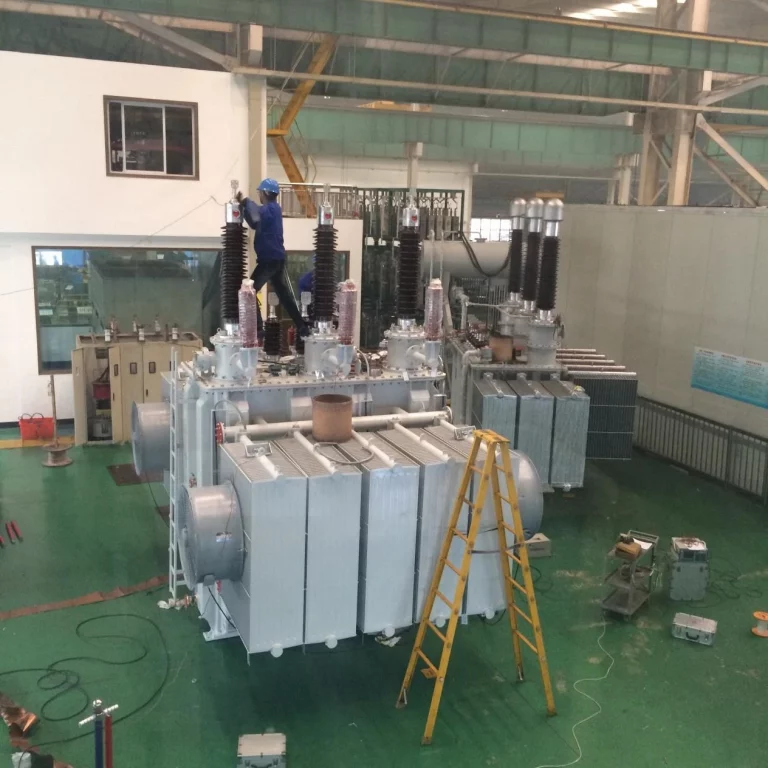
Generator transformers are critical components in power plants, and their specifications are carefully designed to ensure reliable and efficient operation. Here are some common specifications for generator transformers:
Voltage ratio: This specifies the ratio between the high voltage side (connected to the generator) and the low voltage side (connected to the grid).
Power rating: This specifies the maximum amount of power that the transformer can handle. It is usually measured in megavolt-amperes (MVA).
Impedance: This specifies the internal resistance of the transformer and is used to calculate the voltage drop under load conditions.
Frequency: This specifies the operating frequency of the transformer. In most power plants, the frequency is 60 Hz.
Insulation class: This specifies the level of insulation provided for the transformer windings. The insulation class depends on the operating voltage and the environment in which the transformer is installed.
Cooling method: This specifies how the transformer is cooled. The two most common methods are air-cooled and water-cooled.
Efficiency: This specifies the efficiency of the transformer, which is the ratio of output power to input power.
Standards: This specifies the applicable standards that the transformer must meet, such as ANSI, IEC, or IEEE.
The specifications of a generator transformer depend on the specific requirements of the power plant and the generator it is connected to. It is important to choose a transformer that is carefully designed to meet these specifications to ensure reliable and efficient operation of the power plant.
A generator step-up transformer (GSU) is a specific type of transformer used in power plants to increase the voltage of electrical power generated by a generator before it is delivered to the transmission system. The configuration of a GSU transformer is designed to match the electrical characteristics of the generator and the transmission system.
In a typical GSU configuration, the transformer is connected to the generator output and steps up the voltage to the level required by the transmission system. The transformer may also include other components such as tap changers to adjust the voltage level and cooling systems to manage the heat generated by the transformer.
The configuration of a GSU transformer depends on a variety of factors, including the power rating of the generator, the voltage level of the transmission system, and the type of electrical connection used between the generator and the transformer. Proper design and configuration of a GSU transformer is critical to ensuring reliable and efficient operation of the power plant.
Generator transformer protection refers to the measures taken to prevent the transformer from damage or failure due to various electrical faults or abnormalities in the power system. The protection system is designed to detect and isolate faults that can damage the generator transformer or cause a power outage.
There are various types of protection schemes used for generator transformers, including differential protection, overcurrent protection, overvoltage protection, and under frequency protection. The protection scheme is usually determined based on the transformer’s design, application, and size.
Differential protection is the most commonly used protection scheme for generator transformers. It works by measuring the current flowing through the transformer’s primary and secondary windings and comparing them. Any difference in current between the two windings indicates a fault and triggers the protection system to isolate the transformer.
Overcurrent protection is used to detect and isolate faults caused by excessive current flow in the transformer. Overvoltage protection is designed to protect the transformer from voltage surges caused by lightning strikes or switching operations in the power system. Under frequency protection is used to detect frequency deviations that can cause damage to the transformer.
Proper protection of a generator transformer is critical to ensure the safe and reliable operation of the power system.
To order generator transformer parts, you can follow these steps:
Identify the specific parts you need: Before you can order generator transformer parts, you need to identify the specific parts you need. This may include components such as bushings, tap changers, cooling systems, and more.
Find a reputable supplier: Once you have identified the parts you need, you can begin to search for a reputable supplier. Look for suppliers who specialize in generator transformer parts and have a good reputation in the industry. You can also check for reviews and ratings online to help you make an informed decision.
Provide the necessary information: When ordering generator transformer parts, you will need to provide the supplier with the necessary information, such as the make and model of your transformer, the specific parts you need, and any other relevant details.
Confirm pricing and delivery: After providing the necessary information, confirm the pricing and delivery timeline with the supplier. Make sure to inquire about any applicable warranties, returns, or exchanges policies.
Place your order: If you are satisfied with the pricing and delivery timeline, you can place your order with the supplier. Make sure to provide any additional details or instructions to ensure that you receive the correct parts.
Receive and install the parts: Once the parts have been delivered, inspect them for damage or defects. Install the parts according to the manufacturer’s instructions or consult a professional if necessary.
Overall, ordering generator transformer parts requires careful research, communication, and attention to detail to ensure that you receive high-quality components that meet your specific needs.
When you need to find more than just existing transformers, Daelim’s Transformer Service Center can help you design and produce distribution transformers that meet your unique needs.
We have our own factory and a professional team of engineers, which can design and modify application requirements that meet all your conditions.
Download Resource
After filling in the contact information, you can download the PDF.